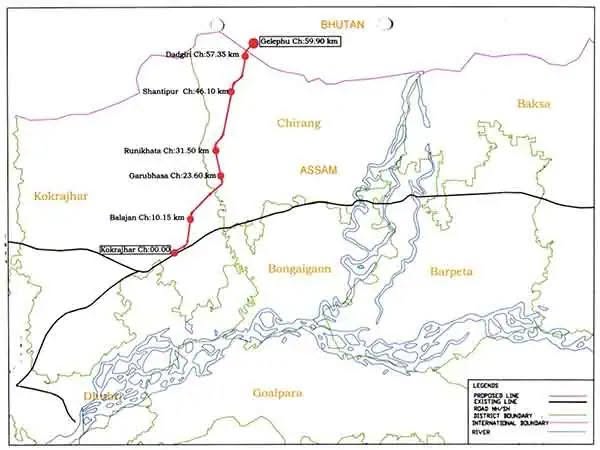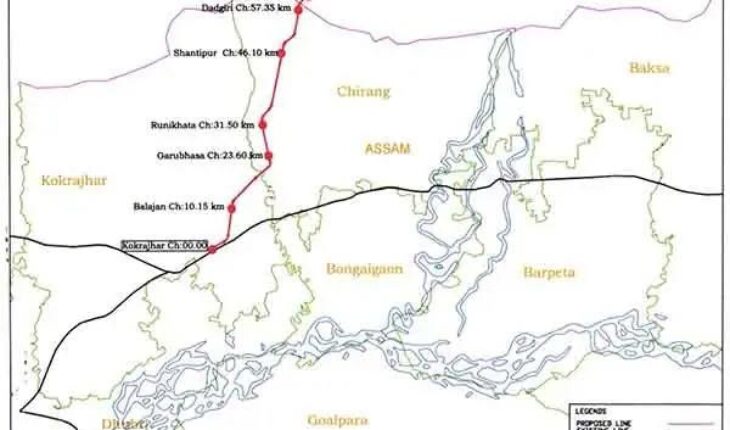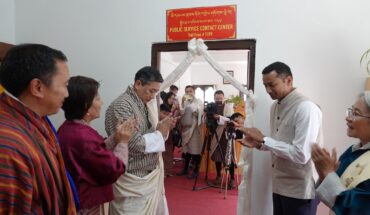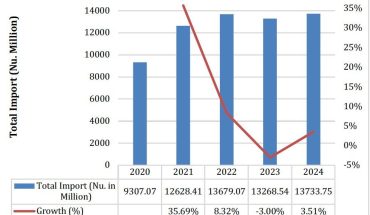
KINZANG DORJI TSHERING
New Delhi
he first-ever railway connection between Bhutan and India is on the cusp of materialization, as the proposed Kokrajhar–Gelephu railway line inches closer to official approval.
Spanning approximately 69 kilometres from Kokrajhar in Assam to Gelephu in southern Bhutan, the project has completed its Detailed Project Report (DPR) and awaits final clearance from both governments.
According to multiple Indian media outlets, including NDTV and The Assam Tribune, and corroborated by sources familiar with the project, the survey phase has concluded and the engineering blueprint has been finalized.
The rail corridor, estimated to cost Nu. 35 billion, will feature six stations: Balajan, Garubhasa, Runikhata, Shantipur, Dadgiri, and Gelephu. Construction designs have accounted for challenging topography with the inclusion of viaducts, major and minor bridges, and grade-separated crossings to ensure seamless and safe transit.
The strategic significance of this railway cannot be overstated. Gelephu, already earmarked for large-scale transformation under His Majesty The King’s vision for a Mindfulness City, stands to gain from the added connectivity.
Gelephu resident and entrepreneur Karma Dorji, 39, expressed cautious enthusiasm.
“We’ve waited years for better connectivity. Roads are slow and expensive. If this railway becomes real, it will be like opening a second lung for our economy. But we hope the government will make sure our environment and way of life are protected,” he said, standing near the local truck depot where goods from India are currently offloaded manually.
For Karma, whose family runs a small wholesale business dealing in building materials and grocery imports, the railway represents more than just new transport—it promises lower logistics costs and wider access to Indian markets.
The Kokrajhar–Gelephu route is the most advanced among several cross-border railway projects proposed under a 2005 Memorandum of Understanding (MoU) between Bhutan and India.
Other proposed corridors include Banarhat–Samtse, Hasimara–Phuentsholing, Rangiya–Samdrup Jongkhar, and Pathsala–Nanglam.
While preliminary surveys have taken place for these routes, none have achieved the readiness level of the Kokrajhar–Gelephu line.
The Banarhat–Samtse corridor, for instance, saw some movement in 2024, when survey teams visited seven potential locations in Samtse district. Most sites were deemed unviable due to high flood risk and lack of elevation.
Eventually, only the site near Damdum Industrial Park was shortlisted, with a DPR expected by late 2025, according to a report.
In contrast, the Kokrajhar–Gelephu proposal has garnered sustained attention from both technical and political circles.
With India’s Ministry of Railways leading the feasibility studies and the Rail Vikas Nigam Limited (RVNL) providing the engineering support, the Indian side has maintained consistent momentum.
Bhutan, known for its cautious approach to infrastructure development, has so far refrained from issuing formal commitments but has reportedly facilitated survey access and topographical data sharing.
If realized, the project would mark a historic milestone: Bhutan’s first-ever integration into a cross-border railway network.
At present, the country lacks a domestic railway system, relying entirely on road and air links. Border towns such as Phuentsholing, Samdrup Jongkhar, and Gelephu serve as the main access points for Bhutanese traders and travellers entering India.
The completion of the railway would reduce Bhutan’s dependence on long and often congested roadways, especially for goods transport.
Currently, freight trucks from India carry bulk goods across narrow highways that are susceptible to landslides and weather-related delays.
According to a Bhutanese engineer associated informally with the planning process, “The reduction in logistics cost alone could save importers and exporters millions of ngultrum annually. Especially for southern Bhutan, this could drive an economic boost.
The project aligns closely with India’s Neighbourhood First and Act East policies, which seek to build stronger trade, energy, and transit linkages with eastern neighbours.
From Bhutan’s perspective, it offers a pragmatic opportunity to diversify its connectivity portfolio while retaining control over infrastructure implementation on its soi
Indian officials have already signalled their readiness to fund the full construction cost of the Kokrajhar–Gelephu line, echoing past support for major Bhutanese hydropower projects.
The financing model would be similar—grants or soft loans, accompanied by Indian technical expertise. Discussions are also underway regarding operation and maintenance responsibilities.
While Indian Railways is expected to oversee early-stage operations, Bhutanese authorities may gradually assume control or opt for a joint management model.
Despite the benefits, concerns persist—particularly regarding environmental impact. Bhutan’s Constitution mandates that a minimum of 60% of the country remain forested at all times, and any infrastructure project must undergo stringent environmental impact assessments (EIA).
Preliminary reports suggest that route alignment has been designed to avoid ecologically sensitive zones.
However, Namgay Lhamo, a 24-year-old student from the Royal Thimphu College, said many young Bhutanese are watching closely. “We want progress, but not the kind that damages our biodiversity. I hope our government listens to environmentalists before saying yes to any railway,” she said.
Cultural preservation is another consideration. Bhutanese society has long maintained a balance between tradition and development. Infrastructure projects that are too rapid or externally managed risk creating social and economic rifts.
To this end, project planners are reportedly holding consultations with local communities, monks, and municipal leaders to ensure that the project reflects Bhutanese values and avoids socially disruptive land acquisition practices.
Though construction has yet to begin, industry insiders suggest that groundwork could commence by 2026 if approvals are granted within the current fiscal year.
The project’s construction phase is expected to span three to four years, taking into account seasonal rainfall, terrain complexity, and cross-border coordination.
In the meantime, ministries from both sides are conducting final due diligence, including land verification, risk mitigation, and budget finalization.
Sources familiar with the project indicate that Bhutan’s internal review process could take several more months due to the need for inter-ministerial consensus.
Training programs for Bhutanese railway personnel may also be introduced as part of capacity-building cooperation between the two nations.
As Karma Dorji put it: “We don’t want to lose what makes us Bhutanese. But we also want a future where our children can build, trade, and thrive. If done right, this railway could be our bridge to that future.”
While the final green signal remains pending, all indicators point toward a new chapter in Bhutan’s connectivity story—one that balances development with dignity, and progress with preservation.





